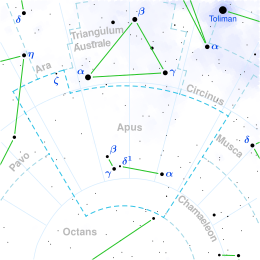
Summary
Epsilon Apodis, Latinized from ε Apodis, is the Bayer designation for a star in the southern circumpolar constellation of Apus. It has an apparent visual magnitude of 5.06,[2] which is bright enough to be viewed from dark suburban skies. Based upon parallax measurements, it is at a distance of roughly 640 light-years (200 parsecs) from Earth.[1]
| Observation data Epoch J2000 Equinox J2000 | |
|---|---|
| Constellation | Apus |
| Right ascension | 14h 22m 23.16467s[1] |
| Declination | −80° 06′ 32.2053″[1] |
| Apparent magnitude (V) | 5.06[2] |
| Characteristics | |
| Spectral type | B3 V[3] |
| U−B color index | −0.610[2] |
| B−V color index | −0.121[2] |
| Variable type | γ Cas[4] |
| Astrometry | |
| Radial velocity (Rv) | +4.5[5] km/s |
| Proper motion (μ) | RA: −9.51[1] mas/yr Dec.: −14.34[1] mas/yr |
| Parallax (π) | 5.06 ± 0.22 mas[1] |
| Distance | 640 ± 30 ly (198 ± 9 pc) |
| Absolute magnitude (MV) | −1.41[6] |
| Details | |
| Mass | 6.15±0.71[7] M☉ |
| Radius | 3.9[8] R☉ |
| Luminosity | 1,614[7] L☉ |
| Surface gravity (log g) | 4.18[9] cgs |
| Temperature | 17,050[7] K |
| Metallicity [Fe/H] | −0.02[9] dex |
| Rotational velocity (v sin i) | 255[10] km/s |
| Age | 38.3±4.4[11] Myr |
| Other designations | |
| Database references | |
| SIMBAD | data |

Based upon a stellar classification of B3 V,[3] this is a massive, B-type main sequence star that is generating energy through the fusion of hydrogen at its core. Epsilon Apodis has more than six[7] times the mass of the Sun and nearly four[8] times the Sun's radius. It is radiating 1,614[7] times as much luminosity as the Sun from its outer envelope at an effective temperature of 17,050 K.[7] At this heat, it has a blue-white glow that is a characteristic of B-type stars.[14]
It is spinning rapidly, with a projected rotational velocity of 255 km/s[10] giving a lower bound for the azimuthal velocity along the equator. Epsilon Apodis is classified as a Gamma Cassiopeiae type[4] variable star and its brightness varies between magnitudes 4.99 and 5.04.[15]
Naming edit
In Chinese caused by adaptation of the European southern hemisphere constellations into the Chinese system, 異雀 (Yì Què), meaning Exotic Bird, refers to an asterism consisting of ε Apodis, ζ Apodis, ι Apodis, β Apodis, γ Apodis, δ Octantis, δ1 Apodis, η Apodis and α Apodis. Consequently, ε Apodis itself is known as 異雀九 (Yì Què jiǔ, English: the Ninth Star of Exotic Bird.)[16]
References edit
- ^ a b c d e f van Leeuwen, F. (November 2007), "Validation of the new Hipparcos reduction", Astronomy and Astrophysics, 474 (2): 653–664, arXiv:0708.1752, Bibcode:2007A&A...474..653V, doi:10.1051/0004-6361:20078357, S2CID 18759600.
- ^ a b c d Gutierrez-Moreno, Adelina; Moreno, Hugo (June 1968), "A photometric investigation of the Scorpio-Centaurus association", Astrophysical Journal Supplement, 15: 459, Bibcode:1968ApJS...15..459G, doi:10.1086/190168.
- ^ a b Houk, Nancy (1979), Michigan catalogue of two-dimensional spectral types for the HD stars, vol. 1, Ann Arbor, Michigan: Dept. of Astronomy, University of Michigan, Bibcode:1978mcts.book.....H.
- ^ a b Kazarovets, E. V.; et al. (January 1999), "The 74th Special Name-list of Variable Stars", Information Bulletin on Variable Stars, 4659: 1, Bibcode:1999IBVS.4659....1K.
- ^ Evans, D. S. (June 20–24, 1966), "The Revision of the General Catalogue of Radial Velocities", in Batten, Alan Henry; Heard, John Frederick (eds.), Determination of Radial Velocities and their Applications, Proceedings from IAU Symposium no. 30, vol. 30, University of Toronto: International Astronomical Union, p. 57, Bibcode:1967IAUS...30...57E.
- ^ Anderson, E.; Francis, Ch. (2012), "XHIP: An extended hipparcos compilation", Astronomy Letters, 38 (5): 331, arXiv:1108.4971, Bibcode:2012AstL...38..331A, doi:10.1134/S1063773712050015, S2CID 119257644.
- ^ a b c d e f Hohle, M. M.; Neuhäuser, R.; Schutz, B. F. (April 2010), "Masses and luminosities of O- and B-type stars and red supergiants", Astronomische Nachrichten, 331 (4): 349, arXiv:1003.2335, Bibcode:2010AN....331..349H, doi:10.1002/asna.200911355, S2CID 111387483.
- ^ a b Pasinetti Fracassini, L. E.; Pastori, L.; Covino, S.; Pozzi, A. (February 2001). "Catalogue of Apparent Diameters and Absolute Radii of Stars (CADARS) - Third edition - Comments and statistics". Astronomy and Astrophysics. 367 (2): 521–524. arXiv:astro-ph/0012289. Bibcode:2001A&A...367..521P. doi:10.1051/0004-6361:20000451. S2CID 425754.
- ^ a b Saffe, C.; et al. (October 2008), "Spectroscopic metallicities of Vega-like stars", Astronomy and Astrophysics, 490 (1): 297–305, arXiv:0805.3936, Bibcode:2008A&A...490..297S, doi:10.1051/0004-6361:200810260, S2CID 15059920.
- ^ a b Uesugi, Akira; Fukuda, Ichiro (1970), "Catalogue of rotational velocities of the stars", Contributions from the Institute of Astrophysics and Kwasan Observatory, University of Kyoto, Bibcode:1970crvs.book.....U.
- ^ Tetzlaff, N.; Neuhäuser, R.; Hohle, M. M. (January 2011), "A catalogue of young runaway Hipparcos stars within 3 kpc from the Sun", Monthly Notices of the Royal Astronomical Society, 410 (1): 190–200, arXiv:1007.4883, Bibcode:2011MNRAS.410..190T, doi:10.1111/j.1365-2966.2010.17434.x, S2CID 118629873.
- ^ "eps Aps -- Be Star", SIMBAD, Centre de Données astronomiques de Strasbourg, retrieved 2012-07-08.
- ^ "Hipparcos Tools Interactive Data Access". Hipparcos. ESA. Retrieved 8 December 2021.
- ^ "The Colour of Stars", Australia Telescope, Outreach and Education, Commonwealth Scientific and Industrial Research Organisation, December 21, 2004, archived from the original on 2012-03-18, retrieved 2012-01-16.
- ^ Samus, N. N.; Durlevich, O. V.; Kazarovets, R. V., "eps Aps", General Catalogue of Variable Stars, Sternberg Astronomical Institute, retrieved 2012-07-09.
- ^ (in Chinese) AEEA (Activities of Exhibition and Education in Astronomy) 天文教育資訊網 2006 年 7 月 29 日 Archived 2011-05-22 at the Wayback Machine
External links edit
- Simbad
- Image Epsilon Apodis



